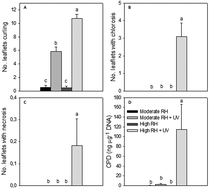Elevated air humidity increases UV mediated leaf and DNA damage in pea (Pisum sativum) due to reduced flavonoid content and antioxidant power
Abstract
Growth in high relative air humidity (RH, >85%) affects plant morphology and causes diminished response to stomatal closing signals. Many greenhouses are prone to high RH conditions, which may negatively affect production and post-harvest quality. UV radiation induces stomatal closure in several species, and facilitates disease control. We hypothesised that UV exposure may trigger stomatal closure in pea plants (Pisum sativum) grown in high RH, thereby restoring stomatal function. The effects of UV exposure were tested on plants grown in moderate (60%) or high (90%) RH. UV exposure occurred at night, according to a disease control protocol. Lower stomatal conductance rates were found in UV-exposed plants, though UV exposure did not improve the rate of response to closing stimuli or desiccation tolerance. UV-exposed plants showed leaf curling, chlorosis, necrosis, and DNA damage measured by the presence of cyclobutane pyrimidine dimers (CPD), all of which were significantly greater in high RH plants. These plants also had lower total flavonoid content than moderate RH plants, and UV-exposed plants had less than controls. Plants exposed to UV had a higher content of cuticular layer uronic compounds than control plants. However, high RH plants had a higher relative amount of cuticular waxes, but decreased proteins and uronic compounds. Plants grown in high RH had reduced foliar antioxidant power compared to moderate RH. These results indicate that high RH plants were more susceptible to UV-induced damage than moderate RH plants due to reduced flavonoid content and oxidative stress defence.

- This article is part of the themed collection: Plant responses to UV


 Please wait while we load your content...
Please wait while we load your content...